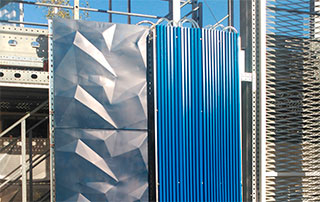This report elucidates specific barriers and solutions for the use of distributed energy sources (DER) in ULT DH networks. Moreover, it will sketch solutions for producer connections to the network. The objective of this document is to investigate possible interconnection schemes for producer installations and to explore the control opportunities and strategies including local storage when relevant and with respect to the overall boundary conditions, pricing and taxes as well as regulation. DOWNLOAD DOCUMENT>>

Example of BILST facade system. Source: IMAR singular metal solution.
In RELaTED Task 2.3 the use of distributed energy sources and the possibilities for integration and control in district heating systems are presented along with legal and practical barriers and solutions as well as pricing options for energy sales.
Different distributed energy sources are described and discussed in relation to integration along with other heat sources and how these supplementary heat sources can be controlled and utilised in a DH system.
Description of legal and practical barriers along with pricing models for local DH production are presented to clarify the challenges these barriers represent. A few cases from some of the participating countries are used to show how these barriers can be handled in practice. Seasonal storage can be a possible solution for some of these challenges but are not discussed in this report.
A set of sketches showing possible connections of distributed energy sources to district heating networks are compiled to help understanding the necessary technological solutions described in this report.
A set of sketches showing possible connections of distributed energy sources to district heating networks are compiled to help understanding the necessary technological solutions described in this report.
The information gathered in this report will be used to investigate further the architecture of the ULT concept, design and adaption of subsystems to facilitate the use of distributed energy resources, analyse the economic feasibility and business case and prepare and conduct demonstrations, of the RELaTED project.
The content of this report is sectioned as follow:
1. Executive summary. Contains a summary of the report.
2. Introduction. Introduces the report, the objective and the methodology
3. ULT DH heat sources, storages and control. Description of relevant distributed energy sources: Solar heating, heat pumps, surplus heat and geothermal heat. Description of technologies for storage, connection and exchange of DER’s.
4. Barriers for local ULT DH producers. Description of legislation of heat delivery, pricing models and practical barriers.
5. Solutions for ULT DH producers in practice based on cases from some of the participating countries.
6. Interconnection schemes for producer installations. Examples of interconnections schemes for producer only installations and for combined producer and consumer installation with the use of triple function substations (3FS). Various connections for delivery of heat to both supply and return line is sketched.
